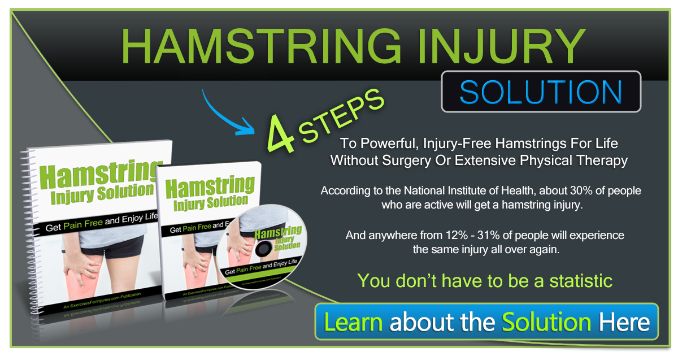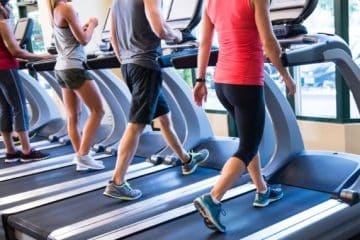Welcome to a journey that will unlock the gates to post-workout bliss! We all know that refreshing feeling after a challenging workout – those endorphins flowing, muscles awakened, and a sense of accomplishment that can't be beaten. But what about the aftermath? Discover the power of stretches for your tight hamstrings after your workout—a simple practice with profound benefits. Learn why these stretches are essential, from reducing tensions in your hamstring muscles to enhancing flexibility. Your hamstrings will become your best friends; we're here to show you how!
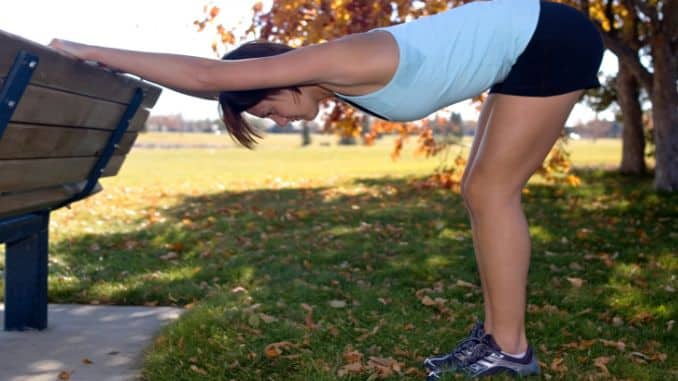 Where are the Hamstrings Located?
Where are the Hamstrings Located?
The three muscles located at the back of your thigh are hamstrings. These are the following:
- Biceps femoris
- Semitendinosus
- Semimembranosus
These muscles originate at the ischial tuberosity of the pelvis and insert at the fibular head and tibial tuberosity of the knee joint.
Hamstrings are responsible for the following:
- Extending the hip joint
- Flexing the knee joint
- Rotating the lower leg
They are also involved in maintaining stability at the hip and knee joints. The hamstrings are the three muscles that run from the sitting bones to the back of the knees. They are responsible for straightening the leg at the hip and bending it at the knee. Hamstrings are also involved in rotating the lower leg inwards. The hamstrings are important for various activities, including running, jumping, and kicking. They are also important for maintaining good posture and balance.
The Role of the Hamstrings in Exercise and Flexibility
The hamstrings are often overlooked muscles. These powerful muscles affect your mobility and interact intricately with your hip flexors, abdominal muscles, and even the delicate sciatic nerve, making them key players in your quest for a healthier, more flexible you.
-
Leg Flexion
Imagine bending your knee, like when you bring your heel towards your bum. That's your hamstrings hard at work, providing the power for this movement. Whether you're walking, running, or doing a leg curl at the gym, your hamstrings are there, helping you out.
-
Hip Extension
When you push your hips forward as you stand up from a seated position or extend your leg backward, you use your hamstrings to perform these actions. They're crucial for maintaining proper posture and balance.
-
Flexibility
Hamstring flexibility can make a difference in your daily life and workouts. Flexible hamstrings help you reach your toes, bend comfortably, and improve your athletic performance. Stretching your hamstrings regularly can reduce the risk of muscle strains and increase your range of motion.
Importance of Regular Hamstrings Stretch
Regular hamstring stretches are essential for maintaining a balanced and flexible body, especially if you engage in regular physical activity. The hamstrings consist of three muscles at the back of your thighs: the biceps femoris, semitendinosus, and semimembranosus. These muscles are crucial in various movements, such as walking, running, jumping, and bending the knees. Here are some key reasons why stretching your hamstrings is important:
1. Reduce Muscle Tension
Participating in physical activities, especially those that engage the lower body, may result in back discomfort due to muscle tension and tightness in the hamstrings. Stretching these muscles helps release tension and relax tight muscles, alleviating back pain, discomfort, and soreness.
2. Prevent Injury
Tight hamstrings can increase the risk of various injuries, including strains, pulls, and lower back pain. Regular stretching helps maintain the suppleness of these muscles, reducing the likelihood of hamstring injury during physical activities.
3. Improve Posture
Tight hamstrings can contribute to poor posture as they pull on the pelvis and cause the lower back to round. Stretching the hamstrings can help alleviate this tension, promoting a more upright and balanced posture.
4. Enhance Athletic Performance
Flexible hamstrings are crucial for optimal athletic performance, as they contribute to proper movement mechanics, power generation, and injury prevention. Chronic tightness and tension in your hamstrings can significantly impede your performance, preventing you from reaching your full potential.
5. Accelerate Recovery
After an intense workout, your muscles can experience micro-tears that lead to soreness. Stretching the hamstrings increases blood flow to the area, which aids in the healing process and reduces hamstring muscle stiffness.
6. Promote Blood Circulation
Stretching stimulates blood circulation to the muscles, which can help deliver nutrients and oxygen while removing waste products. This aids in muscle recovery and overall tissue health.
The Ideal Timing for Post-Workout Hamstring Exercises
Immediately after your workout. This is because your muscles are warm and pliable after exercise, making them easier to stretch. Stretching your hamstrings after a workout can help to improve your flexibility, reduce muscle soreness, and prevent injuries.
However, if you cannot stretch immediately after your workout, you can also stretch your hamstrings 10-15 minutes later or later in the day. Just be sure to warm up your muscles before stretching, even if you are stretching later in the day. You can do this by taking a warm shower or bath or doing light cardio, such as walking or jogging.
Here are some tips for stretching your hamstrings after a workout:
- Hold each stretch for 10-30 seconds.
- Breathe deeply and evenly while
- Do not bounce while
- If you feel pain, stop immediately.
5 Hamstring Stretches To Avoid Soreness After Exercise
1. Seated Hamstring Stretch
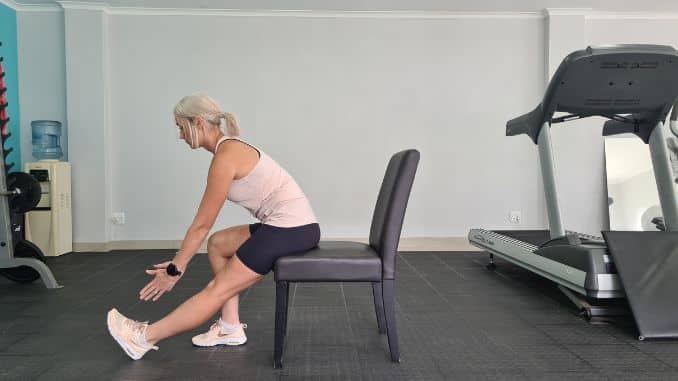
Seated Hamstring Stretch
For this exercise, use a stable chair to sit on.
Begin in an upright sitting position on the edge of the chair with your knees bent and feet flat on the floor, maintaining good alignment with your head, shoulders, and hips. Straighten one leg out in front of your body with your toes pointed upward. Engage your core. Hinge through your hips to bend your upper body forward, reaching towards your foot with both hands. Hold the position for several deep belly breaths, in through your nose and out through your mouth. Relax and repeat the movement on the opposite side.
2. Bend Over Hamstring Stretch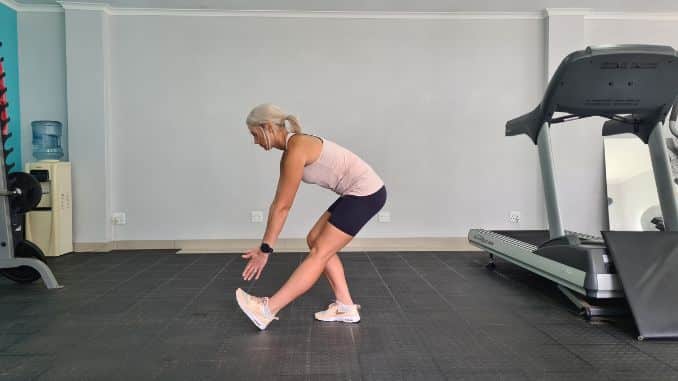
Bend Over Hamstring Stretch
Begin in an upright standing position with your feet hip-width apart, maintaining good alignment with your head, shoulders, hips, and legs. Bring one foot forward with your toes pointing toward the ceiling and engage your core. Hinge through your hips to bend your upper body forward, reaching for your toes with both hands while keeping your back straight. Hold the position for several deep belly breaths, in through your nose and out through your mouth. Relax and return to the starting position. Repeat the movement on the opposite side.
3. Reclined Hamstring Stretch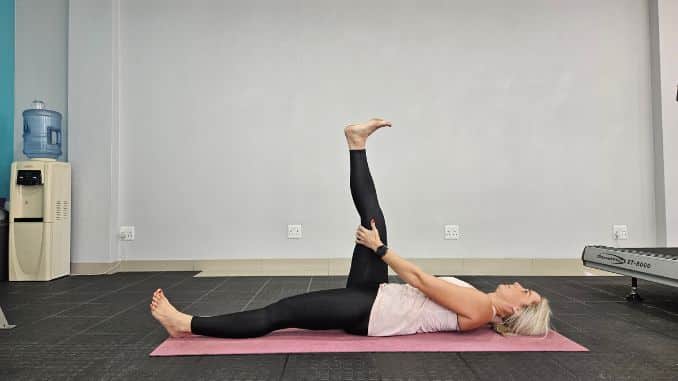
Reclined Hamstring Stretch
Lie on your back on the floor, maintaining good alignment with your head, shoulders, hips, and legs. Engage your core and raise one leg up towards the ceiling, using your hands as support if needed. Hold the position for several deep belly breaths, in through your nose and out through your mouth. Relax and return to the starting position. Repeat the movement on the opposite side.
4. Wall Hamstring Stretch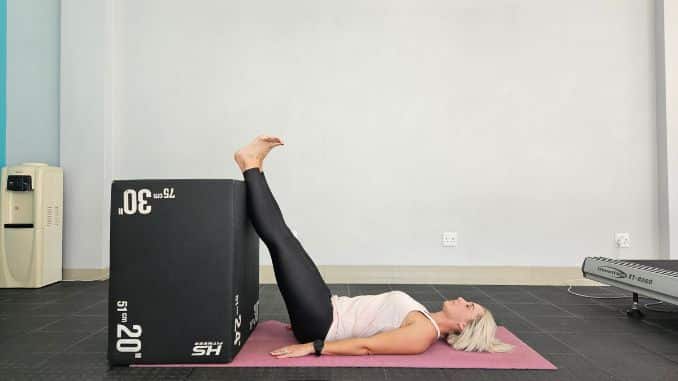
Wall Hamstring Stretch
For this exercise, use the wall, PlyoBox, or anything stable that you can lean your legs on.
Move towards the wall, then lie on your back on the floor with your hands at your sides. Raise both legs up against the wall and hold the position for several deep belly breaths, in through your nose and out through your mouth. Relax and return to the starting position.
5. Standing Hamstring Stretch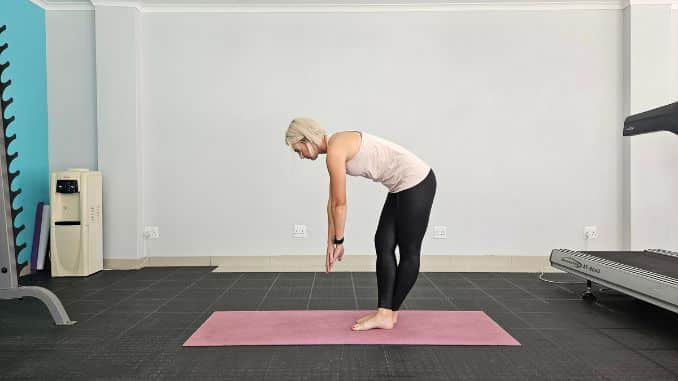
Standing Hamstring Stretch
Begin in an upright standing position, maintaining good alignment with your head, shoulders, hips, and legs. Cross one foot over your opposite ankle. Tighten your core and hinge through your hips to bend your upper body forward, lowering your arms to the floor. Hold this position for several deep belly breaths, in through your nose and out through your mouth. Relax and return to the starting position. Repeat the movement on the opposite side
For these stretches, depending on your comfort level, repeat the movement with 1 set of two repetitions, alternating sides for 20 seconds or a couple of minutes.
In addition to the above movements, here are other hamstring stretches you can incorporate into your daily exercises.
- Seated Hamstring Stretch
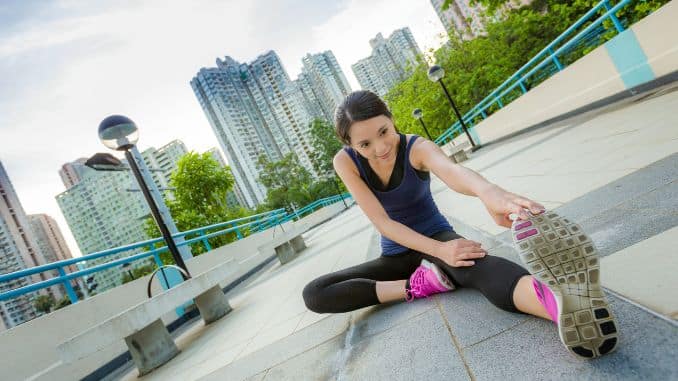
Seated Hamstring Stretch
Sit on the floor with your legs crossed in front of your body. Extend your left leg out at an angle and engage your core. Bend your upper body forward, reaching for your toes with your left hand. Hold the stretch for a few seconds. Gently return to the starting position and repeat the movement on the opposite side.
-
Hamstring Stretch with a Strap
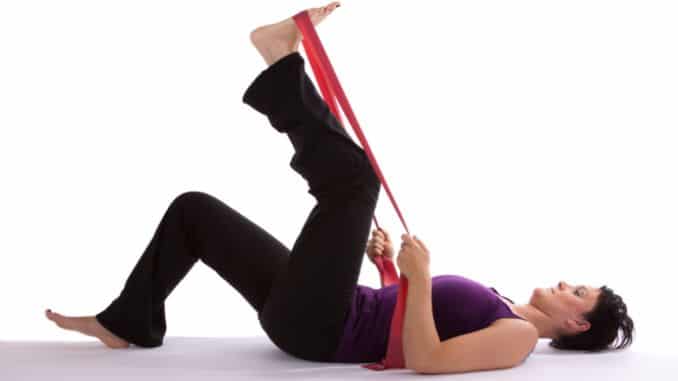
Hamstring Stretch with a Strap
Lie on your back on the floor with your knees bent, relaxing your upper body. Wrap the middle of the strap under the bottom of one foot and raise your leg up towards the ceiling with your toes pointing toward you. Gently pull on the strap to intensify the stretch. Keep your opposite leg bent or straight, depending on your comfort level. Hold this position for a couple of seconds. Lower your leg to the starting position and repeat the movement on the opposite side.
What Causes Tight Hamstrings?
Tight hamstrings are a widespread issue that many people encounter, whether they lead an active lifestyle or have a more sedentary routine. Several factors can contribute to the tightness experienced in the muscles at the back of the thighs. Understanding these causes can help you take proactive steps to prevent or address tight hamstrings. Here are some common reasons:
-
Sedentary Lifestyle
Prolonged periods of sitting, such as desk jobs or long hours of screen time, can lead to tight hamstrings. Sitting for extended periods can cause the muscles to shorten and tighten over time.
-
Lack of Stretching
Not incorporating regular hamstring stretching exercises back into your routine can result in muscle stiffness and reduced flexibility. Hamstrings that aren't regularly stretched can become less pliable and more prone to tightness.
-
Physical Inactivity
If you're not engaging in regular physical activity, your muscles, including the hamstrings, might not be receiving the necessary stimulus to stay supple. Lack of movement can contribute to muscle tightness.
-
Overexertion
On the flip side, overexerting the hamstrings without proper warm-up or cool-down can lead to muscle tightness. Intense workouts or sudden increases in exercise intensity can strain the muscles and cause tightness.
-
Muscle Imbalances
Imbalances between the quadriceps (front thigh muscles) and hamstrings can lead to tightness. If the quadriceps are stronger or more dominant, they can cause the hamstrings to become overly stretched and potentially tight.
-
Improper Form
Incorrect form during exercises that involve the hamstrings, such as deadlifts or squats, can lead to muscle strain and tightness. Proper technique is crucial to prevent unnecessary stress on the muscles.
-
Inadequate Warm-Up
Skipping even a few minutes of proper warm-up before exercise can leave your muscles unprepared for the physical demands, making them more susceptible to tightness and injury.
-
Aging
As we age, our muscles naturally lose some flexibility and elasticity. This can contribute to tightness, especially if proper stretching routines aren't maintained.
-
Dehydration
Lack of adequate hydration can lead to muscle cramps and tightness. Muscles require proper hydration to function optimally and remain supple.
-
Stress and Tension
Emotional stress and tension can manifest physically in the body, leading to muscle tightness, including in the hamstrings.
-
Injury or Strain
Previous injuries or strains to the hamstring muscles can result in scar tissue formation, reducing flexibility and increasing the likelihood of tightness.
Tight Hamstrings Prevention
Hamstring Tightness and Its Impact: When our hamstrings become tight, it can cause discomfort, limit our flexibility, and even lead to injuries.
Ways to Prevent Tightness:
1. Regular Stretching Exercises
One of the best ways to prevent tight hamstrings is through regular stretching. Simple stretches like touching your toes or using a yoga strap can help keep these muscles flexible and supple.
2. Strength Training
Building strength in your hamstrings and the surrounding muscles can provide added support, reducing the risk of tightness. Incorporate exercises like leg curls, bridges, and squats into your routine.”
3. Proper Posture
Maintaining proper posture throughout the day is crucial to avoid developing tight hamstrings. When you sit or stand with good alignment, you reduce the strain on these muscles.
4. Hydration and Nutrition
Staying well-hydrated and eating a balanced diet can contribute to muscle health. Dehydration can lead to muscle cramps and tightness.
5. Massage Therapy
Massage therapy can also help to prevent tight hamstrings by improving posture and alignment. When the body is properly aligned, the hamstrings are less likely to become tight and overused.
6. Utilizing Yoga Block
Yoga blocks can be a useful tool for preventing tight hamstrings by allowing you to deepen your stretches and hold them for longer periods. This is because blocks can help support your body weight and lessen the strain on your muscles.
7. Do Butterfly Position when Sitting or Lying
This position helps to prevent tight hamstrings by lengthening the muscles in a shortened position. When we sit or stand for long periods, our hamstrings are shortened. This can lead to tightness and stiffness in the muscles, increasing the risk of injury. The butterfly position helps to counteract this by stretching the hamstrings and restoring their full range of motion.
Loosen Tight Hamstrings Bring Joy: The wonderful feeling of having loose hamstrings. You'll experience increased mobility, less discomfort, and better athletic performance when your hamstrings are loose. You'll be able to reach for your toes effortlessly, move more freely during workouts, and enjoy everyday activities without the nagging discomfort of tight muscles.
Seeking Help from a Physical Therapist
If you've been dealing with tight hamstrings, consulting a physical therapist or a licensed massage is a great idea. These professionals are experts at understanding the intricacies of muscle imbalances. They can create a personalized plan to help you loosen up those hamstrings. They can provide you with exercises, stretches, and techniques tailored to your needs.
Tips for Keeping Your Hamstrings Loose
Here are some friendly tips to help you maintain flexible and happy hamstrings:
- Regular Stretching: Incorporate hamstring stretches into your daily routine. It only takes a few minutes and can make a world of difference.
- Strengthening Exercises: Strengthen the opposing muscle groups to maintain a balanced musculature.
- Stay Active: Don't let a sedentary lifestyle get the best of you. Regular physical activity can keep your hamstrings supple.
- Proper Warm-Up and Cool-Down: Before and after exercising, ensure you warm up and cool down adequately to prevent muscle tightness.
Conclusion
Taking care of your hamstrings is a crucial part of any fitness routine. The five hamstring stretches we've explored here effectively prevent soreness after exercise and contribute to your overall flexibility and well-being. Remember, your body is an incredible machine, and by dedicating a few minutes to these stretches, you're giving it the love and care it deserves.
Incorporating these five hamstring stretches into your post-workout routine can help you unlock comfort and relieve the tension of tight hamstrings, leaving you feeling blissfully relaxed.
So, as you embark on your fitness journey or continue to push your limits, don't forget the importance of these stretches. Embrace them as a way to stay active, pain-free, and energized.


